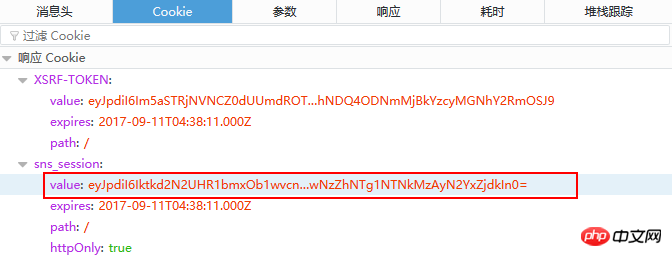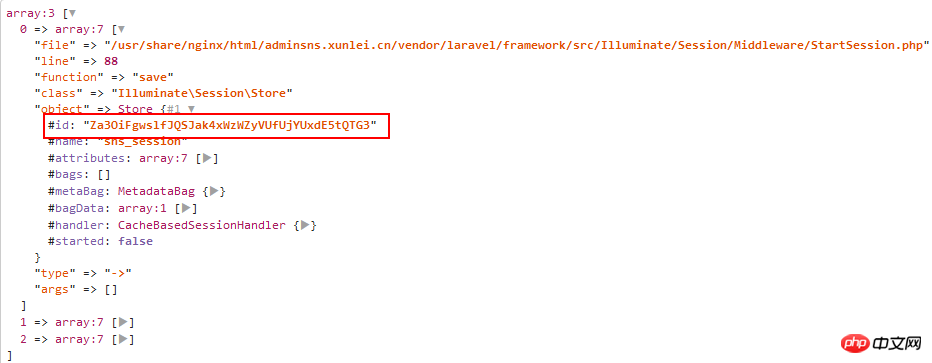 Backend Development
Backend Development
 PHP Tutorial
PHP Tutorial
 Detailed explanation of Sessionid processing mechanism in Laravel
Detailed explanation of Sessionid processing mechanism in Laravel
Detailed explanation of Sessionid processing mechanism in Laravel
This article mainly introduces you to the relevant information about the Sessionid processing mechanism in Laravel. The article introduces it in great detail through sample code. It has certain reference learning value for everyone's study or work. Friends who need it follow the editor below. Come and learn together. I hope to be helpful.
Preface
This article mainly introduces to you the relevant content about the Sessionid processing mechanism in Laravel, and shares it for your reference and study. The following words Not much more to say, let’s take a look at the detailed introduction.
Session Cookie Name can be set in Laravel's configuration file config/session.php. For example, in this project, the name is set to "sns_session":
/* |-------------------------------------------------------------------------- | Session Cookie Name |-------------------------------------------------------------------------- | | Here you may change the name of the cookie used to identify a session | instance by ID. The name specified here will get used every time a | new session cookie is created by the framework for every driver. | */ 'cookie' => 'sns_session',
We can see refresh the page and view the cookie , you will find a cookie named sns_session, the name is our custom one.
This sessionid is the bridge between cookie and session. The server uses this sessionid to determine which client the request comes from.
Laravel's sessionid changes every time it is refreshed
However, every time the page is refreshed, this cookie value will change! So how does the server maintain the session? Because your sessionid is always changing.

Laravel encrypts cookies
We are in vendor/laravel/framework/src/Illuminate/ Debug in the save method of Session/Store.php and print the call stack here:
/**
* {@inheritdoc}
*/
public function save()
{
$this->addBagDataToSession();
$this->ageFlashData();
$this->handler->write($this->getId(), $this->prepareForStorage(serialize($this->attributes)));
$this->started = false;
dd(debug_backtrace(DEBUG_BACKTRACE_PROVIDE_OBJECT,5));
}Every time the page is refreshed, the id attribute of the Store object does not actually change. This attribute is the sessionid cookie. value. In other words, the value of sessionid does not change every time, but when the cookie is written, the value changes.

The reason was found in the encrypt method in vendor/laravel/framework/src/Illuminate/Cookie/Middleware/EncryptCookies.php. This middleware encrypts all cookie values. Encryption handling, it is included in the web middleware.
protected function encrypt(Response $response)
{
foreach ($response->headers->getCookies() as $cookie) {
if ($this->isDisabled($cookie->getName())) {
continue;
}
$response->headers->setCookie($this->duplicate(
$cookie, $this->encrypter->encrypt($cookie->getValue())
));
}
return $response;
}This encryption method results in different encryption results every time, so it appears that the value of sessionid has changed every time, but in fact it has not changed. This cookie will be decrypted when it is needed.
The purpose of this design of the Laravel framework may be to prevent session hijacking! Consideration is quite comprehensive!
Other supplementary knowledge
Native PHP setting session name
session_name() function:
<?php
/* 设置会话名称为 WebsiteID */
$previous_name = session_name("WebsiteID");
echo "The previous session name was $previous_name<br />";
?>session_name() The function returns the current session name. If the name parameter is specified, the session_name() function will update the session name and return the original session name.
When the request starts, the session name will be reset and stored in the session.name configuration item. Therefore, to set the session name, for each request, the session_name() function needs to be called before calling the session_start() or session_register() function. .
The difference and relationship between COOKIE and SESSION
- ##COOKIE is saved on the client side, while SESSION is saved on the server side
- In terms of security, SESSION is more secure
- From the perspective of the type of content saved, COOKIE only saves characters String (and can be automatically converted into a string)
- From the perspective of the size of the saved content, the content saved by COOKIE is limited and relatively small, while SESSION basically does not have this limitation
- From a performance perspective, using SESSION will put more pressure on the server
- SEEION depends on COOKIE, but if COOKIE is disabled , you can also pass it through the url
Related recommendations:
Explain how to customize encryption in laravel Service
Laravel optimized split routing file
laravel writing APP interface (API)
The above is the detailed content of Detailed explanation of Sessionid processing mechanism in Laravel. For more information, please follow other related articles on the PHP Chinese website!

Hot AI Tools

Undresser.AI Undress
AI-powered app for creating realistic nude photos

AI Clothes Remover
Online AI tool for removing clothes from photos.

Undress AI Tool
Undress images for free

Clothoff.io
AI clothes remover

Video Face Swap
Swap faces in any video effortlessly with our completely free AI face swap tool!

Hot Article

Hot Tools

Notepad++7.3.1
Easy-to-use and free code editor

SublimeText3 Chinese version
Chinese version, very easy to use

Zend Studio 13.0.1
Powerful PHP integrated development environment

Dreamweaver CS6
Visual web development tools

SublimeText3 Mac version
God-level code editing software (SublimeText3)

Hot Topics
 1664
1664
 14
14
 1423
1423
 52
52
 1317
1317
 25
25
 1268
1268
 29
29
 1246
1246
 24
24
 Laravel Introduction Example
Apr 18, 2025 pm 12:45 PM
Laravel Introduction Example
Apr 18, 2025 pm 12:45 PM
Laravel is a PHP framework for easy building of web applications. It provides a range of powerful features including: Installation: Install the Laravel CLI globally with Composer and create applications in the project directory. Routing: Define the relationship between the URL and the handler in routes/web.php. View: Create a view in resources/views to render the application's interface. Database Integration: Provides out-of-the-box integration with databases such as MySQL and uses migration to create and modify tables. Model and Controller: The model represents the database entity and the controller processes HTTP requests.
 Solve caching issues in Craft CMS: Using wiejeben/craft-laravel-mix plug-in
Apr 18, 2025 am 09:24 AM
Solve caching issues in Craft CMS: Using wiejeben/craft-laravel-mix plug-in
Apr 18, 2025 am 09:24 AM
When developing websites using CraftCMS, you often encounter resource file caching problems, especially when you frequently update CSS and JavaScript files, old versions of files may still be cached by the browser, causing users to not see the latest changes in time. This problem not only affects the user experience, but also increases the difficulty of development and debugging. Recently, I encountered similar troubles in my project, and after some exploration, I found the plugin wiejeben/craft-laravel-mix, which perfectly solved my caching problem.
 How to learn Laravel How to learn Laravel for free
Apr 18, 2025 pm 12:51 PM
How to learn Laravel How to learn Laravel for free
Apr 18, 2025 pm 12:51 PM
Want to learn the Laravel framework, but suffer from no resources or economic pressure? This article provides you with free learning of Laravel, teaching you how to use resources such as online platforms, documents and community forums to lay a solid foundation for your PHP development journey from getting started to master.
 Laravel user login function
Apr 18, 2025 pm 12:48 PM
Laravel user login function
Apr 18, 2025 pm 12:48 PM
Laravel provides a comprehensive Auth framework for implementing user login functions, including: Defining user models (Eloquent model), creating login forms (Blade template engine), writing login controllers (inheriting Auth\LoginController), verifying login requests (Auth::attempt) Redirecting after login is successful (redirect) considering security factors: hash passwords, anti-CSRF protection, rate limiting and security headers. In addition, the Auth framework also provides functions such as resetting passwords, registering and verifying emails. For details, please refer to the Laravel documentation: https://laravel.com/doc
 Laravel framework installation method
Apr 18, 2025 pm 12:54 PM
Laravel framework installation method
Apr 18, 2025 pm 12:54 PM
Article summary: This article provides detailed step-by-step instructions to guide readers on how to easily install the Laravel framework. Laravel is a powerful PHP framework that speeds up the development process of web applications. This tutorial covers the installation process from system requirements to configuring databases and setting up routing. By following these steps, readers can quickly and efficiently lay a solid foundation for their Laravel project.
 How to view the version number of laravel? How to view the version number of laravel
Apr 18, 2025 pm 01:00 PM
How to view the version number of laravel? How to view the version number of laravel
Apr 18, 2025 pm 01:00 PM
The Laravel framework has built-in methods to easily view its version number to meet the different needs of developers. This article will explore these methods, including using the Composer command line tool, accessing .env files, or obtaining version information through PHP code. These methods are essential for maintaining and managing versioning of Laravel applications.
 What versions of laravel are there? How to choose the version of laravel for beginners
Apr 18, 2025 pm 01:03 PM
What versions of laravel are there? How to choose the version of laravel for beginners
Apr 18, 2025 pm 01:03 PM
In the Laravel framework version selection guide for beginners, this article dives into the version differences of Laravel, designed to assist beginners in making informed choices among many versions. We will focus on the key features of each release, compare their pros and cons, and provide useful advice to help beginners choose the most suitable version of Laravel based on their skill level and project requirements. For beginners, choosing a suitable version of Laravel is crucial because it can significantly impact their learning curve and overall development experience.
 The difference between laravel and thinkphp
Apr 18, 2025 pm 01:09 PM
The difference between laravel and thinkphp
Apr 18, 2025 pm 01:09 PM
Laravel and ThinkPHP are both popular PHP frameworks and have their own advantages and disadvantages in development. This article will compare the two in depth, highlighting their architecture, features, and performance differences to help developers make informed choices based on their specific project needs.



